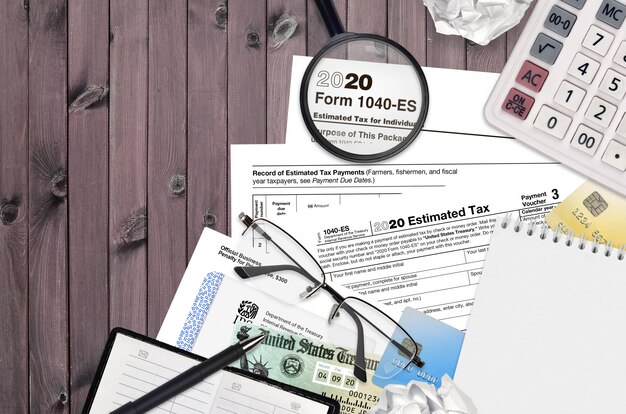Maximize Your 2025 Tax Refund: Uncover 7 Overlooked Tax Deductions

Maximize Your 2025 Tax Refund: Uncover 7 Overlooked Deductions You Can Still Claim by understanding often-missed opportunities like health savings account contributions, student loan interest, and self-employment taxes to potentially increase your tax savings and financial well-being.
Want to maximize your 2025 tax refund? You might be missing out on significant savings. Let’s explore seven often-overlooked tax deductions that could put more money back in your pocket.
Unveiling Hidden Tax Savings: 7 Overlooked Deductions
Tax season can be stressful, but it’s also an opportunity to reduce your tax liability and increase your refund. Many taxpayers focus on common deductions but overlook some valuable ones. Exploring these hidden tax savings could significantly impact your refund.
Here are seven overlooked deductions you should consider when filing your 2025 taxes:
1. Health Savings Account (HSA) Contributions
If you have a high-deductible health plan, you can contribute to a Health Savings Account (HSA). These contributions are tax-deductible, offering a triple tax benefit: tax-free contributions, tax-free growth, and tax-free withdrawals for qualified medical expenses.
Make sure you understand the contribution limits for your situation and document all contributions.
2. Student Loan Interest
Paying off student loans can be a long journey. The good news is that you can deduct the interest paid on these loans, up to a certain limit, even if you don’t itemize. This deduction can reduce your taxable income and potentially lower your tax bill.
Keep track of your student loan interest statements (Form 1098-E) and verify your eligibility.

3. Self-Employment Tax
Self-employed individuals pay both the employer and employee portions of Social Security and Medicare taxes, known as self-employment tax. However, you can deduct one-half of the self-employment tax from your gross income. This can lead to substantial savings for entrepreneurs and freelancers.
- Calculate your self-employment tax using Schedule SE.
- Deduct one-half of the amount from your gross income on Form 1040.
- Keep records of all your self-employment income and expenses.
Understanding and claiming this deduction can significantly lower your overall tax burden.
These initial deductions provide a glimpse into the often-missed opportunities to save on taxes. Let’s delve deeper to further maximize your 2025 tax refund through even more deductions.
More Savings Await: Additional Overlooked Deductions
Beyond the initial deductions, several more overlooked opportunities could decrease your taxable income. From charitable donations to educator expenses, these deductions can make a difference in your tax refund.
Here are four additional deductions that could add to your tax savings:
4. Charitable Donations
Donating to qualified charitable organizations can provide significant tax deductions. These donations can include cash, clothing, and household items. Ensure you document all contributions and obtain written acknowledgments for donations exceeding a certain amount.
Keep receipts and records of all donations, and understand the limits for deducting charitable contributions.
5. Educator Expenses
Teachers and other eligible educators can deduct certain unreimbursed expenses for classroom materials and professional development. This deduction can help offset the costs of supplies and resources used to support students.
Track all expenses, and familiarize yourself with the eligibility requirements and deduction limits.

6. State and Local Taxes (SALT)
The deduction for state and local taxes (SALT) allows taxpayers to deduct certain taxes paid to state and local governments. While there is a limit on the amount you can deduct, it can still provide tax relief, especially for those with high property taxes or state income taxes.
- Include property taxes, state and local income taxes, or sales taxes.
- Be aware of the deduction limit, which may change annually.
- Keep records of all state and local taxes paid.
Carefully calculate your state and local taxes to ensure you claim the maximum allowable deduction.
7. Moving Expenses (for Active Duty Military)
If you’re an active-duty member of the military and move due to a permanent change of station, you may be able to deduct your moving expenses. This can include the cost of transporting your household goods and personal effects.
- Ensure your move is related to a permanent change of station.
- Keep records of all moving expenses.
- Understand the specific rules and limitations for this deduction.
Take advantage of this deduction if you meet the eligibility requirements.
These additional deductions provide further opportunities to maximize your 2025 tax refund. Staying informed and diligent can significantly reduce your tax liability.
Strategies for Claiming Overlooked Deductions Successfully
Claiming overlooked deductions requires careful planning and attention to detail. Taxpayers need to gather necessary documentation, understand specific rules, and stay informed about changes in tax laws. Implementing effective strategies can help ensure you claim all eligible deductions accurately.
Here are key strategies for claiming overlooked deductions successfully:
1. Keep Detailed Records
Maintaining thorough records is crucial when claiming tax deductions. This includes receipts, invoices, statements, and any other documentation that supports your claims. Organized records make it easier to identify potential deductions and substantiate them if needed.
Use digital tools or spreadsheets to track expenses and donations, and store all documents securely.
2. Stay Informed About Tax Law Changes
Tax laws and regulations can change annually, impacting the availability and eligibility of certain deductions. Staying informed about these changes is essential to ensure you’re claiming the most current and beneficial deductions.
Subscribe to tax news updates, consult with tax professionals, and regularly review IRS publications.
3. Consult with a Tax Professional
Navigating the complexities of tax deductions can be challenging. Consulting with a qualified tax professional can provide valuable insights and guidance. They can help identify overlooked deductions, ensure compliance with tax laws, and optimize your tax strategy.
Seek professional advice from a certified public accountant (CPA) or tax advisor.
By implementing these strategies, taxpayers can confidently and accurately claim overlooked deductions, ultimately leading to higher tax refunds and reduced tax liabilities.
Common Mistakes to Avoid When Claiming Tax Deductions
Even with careful planning, taxpayers can make mistakes when claiming tax deductions. These errors can lead to IRS scrutiny, penalties, or missed opportunities for savings. Avoiding common pitfalls is crucial for a smooth and accurate tax filing process.
Here are some common mistakes to avoid:
1. Neglecting to Keep Adequate Records
Failing to maintain proper documentation is a common mistake. Without receipts and records, it’s challenging to substantiate deductions. Always keep comprehensive records of all relevant expenses and donations.
Store receipts digitally and keep a log of all contributions and expenses.
2. Misunderstanding Deduction Eligibility
Claiming deductions for which you are not eligible can lead to problems with the IRS. Understand the specific requirements and limitations for each deduction before claiming it.
Review IRS guidelines and consult with a tax professional if needed.
3. Overlooking Changes in Tax Laws
Tax laws and rules change frequently, and relying on outdated information can result in errors. Stay up-to-date with the latest tax changes to ensure you’re claiming deductions correctly.
Regularly check for updates from the IRS and reputable tax resources.
4. Not Itemizing When It Benefits You
Some taxpayers automatically take the standard deduction without comparing it to itemized deductions. Calculate both to determine which method results in a lower tax liability.
Use tax preparation software or consult with a tax professional to make this determination.
Avoiding these common mistakes will improve accuracy and help taxpayers maximize your 2025 tax refund.
Planning Ahead: Tax Strategies for 2025 and Beyond
Effective tax planning is an ongoing process that extends beyond the tax filing season. Implementing year-round strategies can help taxpayers optimize their tax situation, reduce their tax liability, and improve their overall financial well-being. Preparing for the future is as important as claiming current deductions.
Here are key tax planning strategies for 2025 and beyond:
1. Maximize Retirement Contributions
Contributing to retirement accounts such as 401(k)s and IRAs can provide significant tax benefits. Contributions are often tax-deductible, and earnings grow tax-deferred. Maximize your contributions to lower your taxable income and build a secure retirement.
Take full advantage of employer matching contributions and explore catch-up contributions if you are age 50 or older.
2. Consider Tax-Advantaged Investments
Investments held in tax-advantaged accounts, such as 529 plans for education savings, can offer tax-free growth and withdrawals for qualified expenses. Consider these options to help reach your financial goals while minimizing your tax burden.
Explore various tax-advantaged investment options and consult with a financial advisor.
3. Review Your Tax Withholding
Regularly review your tax withholding to ensure you’re not overpaying or underpaying your taxes throughout the year. Adjust your W-4 form with your employer to reflect any changes in your income, deductions, or tax situation.
Use the IRS Tax Withholding Estimator tool to help determine the correct withholding amount.
Implementing these planning strategies will help taxpayers proactively maximize your 2025 tax refund and achieve long-term financial success.
Tools and Resources for Tax Deduction Research
Navigating the world of tax deductions can be simplified with the right tools and resources. Taxpayers can leverage various online platforms, software programs, and IRS publications to enhance their understanding and improve their tax filing accuracy.
Here are some valuable tools and resources for tax deduction research:
1. IRS Website and Publications
The IRS website provides a wealth of information on tax laws, deductions, and filing requirements. IRS publications, such as Publication 17 (Your Federal Income Tax), offer detailed guidance on various tax topics.
Visit IRS.gov for the latest tax information and resources.
2. Tax Preparation Software
Tax preparation software programs, such as TurboTax and H&R Block, can help taxpayers identify potential deductions, calculate their tax liability, and file their taxes electronically. These tools often have built-in guidance and support.
Choose a reputable tax preparation software program that fits your needs and budget.
3. Tax Professionals and Advisors
Consulting with a tax professional or advisor can provide personalized guidance and expertise. They can help you navigate complex tax issues, identify overlooked deductions, and optimize your tax strategy.
Find a certified public accountant (CPA) or tax advisor with relevant experience.
Utilizing these tools and resources will empower taxpayers to maximize your 2025 tax refund with greater accuracy and efficiency.
| Key Point | Brief Description |
|---|---|
| 💰 HSA Contributions | Tax-deductible contributions to Health Savings Account for qualified health plans. |
| 🎓 Student Loan Interest | Deduct interest paid on student loans, reducing taxable income. |
| 💼 Self-Employment Tax | Deduct one-half of self-employment tax from gross income for business owners. |
| ❤️ Charitable Donations | Tax deductions for donating to qualified charitable organizations. |
Frequently Asked Questions (FAQs)
▼
An HSA is a health savings account. It offers a triple tax benefit: tax-free contributions, tax-free growth, and tax-free withdrawals for qualified medical expenses. To be eligible, you must have a high-deductible health plan.
▼
You can deduct the interest paid on student loans, up to a certain limit. This limit can vary each year, so it’s important to check the latest IRS guidelines. You’ll receive a Form 1098-E with the amount you paid.
▼
You can include cash, clothing, and household items in charitable donations. Always donate to qualified organizations and keep receipts. For donations exceeding a certain amount, obtain a written acknowledgement from the charity.
▼
Yes, there is a limit on the amount you can deduct for state and local taxes (SALT). This limit may change annually. Be sure to review the current IRS guidelines for the specific limit for the tax year.
▼
A tax professional can provide personalized guidance, identify overlooked deductions, and optimize your tax strategy. They can also help you navigate complex tax issues and ensure compliance with tax laws. Consider consulting with a CPA.
Conclusion
Maximizing your 2025 tax refund involves understanding and claiming often-overlooked deductions. By keeping detailed records, staying informed about tax law changes, and seeking professional advice, you can increase your tax savings and improve your financial well-being. Take the time to explore these deductions and plan for a more rewarding tax season.





